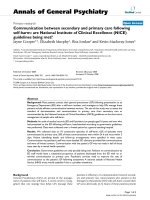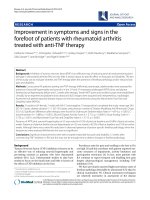Báo cáo y học: " Topics in neuroanaesthesia and intensive care" potx
Bạn đang xem bản rút gọn của tài liệu. Xem và tải ngay bản đầy đủ của tài liệu tại đây (102.47 KB, 1 trang )
463
Available online />Topics in Neuroanaesthesia and Intensive Care aims to
review important experimental and clinical data with
emphasis on up-to-date references in the fields of
neuroanaesthesia and neurointensive care. The book
contains 12 chapters: three chapters on neurophysiology and
clinical measurement, five chapters on neuropharmacology,
one chapter on the sitting position in anaesthesia, and three
chapters relating to neurointensive care. In each chapter, the
authors have aimed to provide the evidence base from both
animal studies and human studies.
The major attraction of the book is the summary of a large
number of studies on various aspects of neurointensive
care and anaesthesia, accompanied by a detailed
bibliography at the end of each chapter. It thus provides a
quick access to the medical literature on a specialized area
of intensive care and anaesthesia, some of which may not
be available on Medline or Pubmed. There are some good
chapters, particularly those on measurement of cerebral
blood flow and acute head injury. However, some
drawbacks do exist.
The main limitation of the book is the style of presentation. The
layout of the headings and the subheadings makes it difficult
for the reader to follow the sequence of presentation, and
every now and then one has to go back a few pages to pick up
on the theme. For example, the simple style of presentation
found in chapter 1 is lost in chapter 2, where regulation of
cerebral blood flow (arterial oxygen tension) and metabolic
regulation of cerebral blood flow are discussed as separate
subheadings. In the latter subsection, the coupling between
oxygen consumption and cerebral blood flow is again
reviewed.
Important sections of neurointensive care such as status
epilepticus, neuromuscular disorders and cerebrovascular
diseases are not covered. The authors in the section on
cerebral ischaemia mention that, as stroke patients do not
come to the neurointensive care unit, these areas will not be
discussed. However, with the advent of thrombolysis for
ischaemic cerebrovascular accidents and more aggressive
surgical drainage of intracerebral haematomata, these
patients are increasingly being referred to the neurointensive
care unit.
Another notable limitation is the relative inequity in the
apportioning of the discussion to experimental data versus
current clinical practice. For example, the discussion on triple-H
therapy for vasospasm occupies one page, while a discussion
of experimental therapies spans more than three pages.
A few factual errors and omissions have crept in.
Page 236: acute lung injury is defined as the ratio of PaO
2
over the fraction of the expired oxygen < 300. It should be
the fraction of the inspired oxygen concentration.
Page 184: in the discussion on sodium nitroprusside toxicity,
there is no mention of renal failure as an important risk factor.
There are also a number of spelling and grammatical errors.
Most of these would be discounted by the knowledgeable
reader.
In our opinion, Topics in Neuroanaesthesia and Intensive
Care would be more suitable for the researcher in basic
neuroscience than for the neuroanaesthetist or the intensivist.
The book may provide additional reading material for those
preparing for the basic science component of anaesthesia
and intensive care examinations, but it is not a textbook in
which detailed clinical information should be sought because
it is by no means complete.
Competing interests
None declared.
Book report
Topics in neuroanaesthesia and intensive care
Bala Venkatesh
1
and Andrea Beindorf
2
1
Associate Professor in Intensive Care, Princess Alexandra & Wesley Hospitals, Queensland, Australia
2
Research Fellow in Intensive Care, Royal Brisbane Hospital, Queensland, Australia
Correspondence: Bala Venkatesh,
Published online: 17 July 2003
Critical Care 2003, 7:463 (DOI 10.1186/cc2346)
This article is online at />© 2003 BioMed Central Ltd (Print ISSN 1364-8535; Online ISSN 1466-609X)
Keywords: book review, intensive care, neuroanaesthesia
Cold GE, Dahl BL: Topics in Neuroanaesthesia and Intensive Care. Berlin: Springer Verlag, 2000.
416 pp. ISBN 3-540-41871-7









